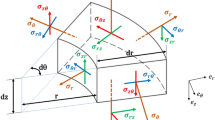Abstract
In this paper, the ultrasonic vibration-assisted grinding is studied, and a new method is provided to solve the problem of matching the machine tool system and the ultrasonic system. By establishing the matching model, this problem is theoretically solved optimally. Moreover, the abrasive grain motion equations, the removal rate model, and grinding force prediction model are presented. Then the grinding force and the processing quality in system matching are researched by numerical simulation. When ultrasonic system parameters exceed the critical value, the surface scallop height of workpiece becomes lower with single-grain track and intergranular track overlapping. The grinding force decreases as the spindle speed, vibration amplitude, and vibration frequency increase. And the grinding force increases as the grinding depth and feed rate increase. Thus, the surface morphology of the workpiece and the change trends of the grinding force can be predicted through the system matching model. As a result, the best ultrasonic equipment can be decided accordingly to cooperate with the machine tool for grinding.
Similar content being viewed by others
References
Spur G, Holl SE (1997) Material removal mechanisms during ultrasonic-assisted grinding. Prod Eng 4(2):9–14
Wu YB, Nomura M, Feng ZJ, Kato M (2004) Modeling of grinding force in constant depth of cut ultrasonically assisted grinding. Mater Sci Forums 471–472:101–106
Qu W, Wang K, Miller MH, Huang Y, Chandra A (2000) Using vibration-assisted grinding to reduce subsurface damage. Precis Eng 24:329–337
Gong H, Fang FZ, Hua XT (2010) Kinematic view of tool life in rotary ultrasonic side milling of hard brittle materials. Int J Mach Tools Manuf 50(3):303–307
Komaraiah M, Narashima Reddy P (1991) Rotary ultrasonic machining—a new cutting process and its performance. Int J Prod Res 29(11):2177–2187
Liu K, Li XP, Rahman M (2008) Characteristics of ultrasonic vibration-assisted ductile mode cutting of tungsten carbide. Int J Adv Manuf Technol 35:833–841
Wang X, Zhou M, Gan JGK, Ngoi B (2002) Theoretical and experimental studies of ultra-precision machining of brittle materials with ultrasonic vibration. Int J Adv Manuf Technol 20:99–102
Kim JD, Choi IH (1998) Characteristics of chip generation by ultrasonic vibration cutting with extremely low cutting velocity. Int J Adv Manuf Technol 14:2–6
Dam H, Quist P, Sehreiber MP (1995) Productivity, surface quality, and tolerances in ultrasonic machining of ceramics. J Mater Process Tech 51(1–4):358–368
Wang QG, Cong WL, Pei ZJ, Gao H (2009) Renke Kang, rotary ultrasonic machining of potassium dihydrogen phosphate (KDP) crystal: an experimental investigation on surface roughness. J Mater Process Tech 11(66):73
Ya G, Qin HW, Yang SC, Xu YW (2002) Analysis of the rotary ultrasonic machining mechanism. J Mater Process Tech 129(1–3):182–185
Brehl DE, Dow TA (2008) Review of vibration-assisted machining. Precis Eng 32(3):153–172
Agarwal S, Rao PV (2010) Modeling and prediction of surface roughness in ceramic grinding. Int J Mach Tools Manuf 50(12):1065–1076
Yan YY, Zhao B, Liu JL (2009) Ultra precision surface finishing of nano-ZrO2 ceramics using two-dimensional ultrasonic assisted grinding. Int J Adv Manuf Technol 43:462–467
Chen HF, Tang JY, Zhou W (2013) An experimental study of the effects of ultrasonic vibration on grinding surface roughness of C45 carbon steel. Int J Adv Manuf Technol. doi:10.1007/s00170 – 013-4824-1
Jiao Y, Hu P, Pei ZJ, Treadwell C (2005) Rotary ultrasonic machining of ceramics: design of experiments. Int J Adv Manuf Technol 7(2–4):192–206
Pei ZJ (1995) Plastic flow in rotary ultrasonic machining of ceramics. J Mater Process Tech 48(1-4):771–777
Pei ZJ, Ferreira PM (1998) Modeling of ductile-mode material removal in rotary ultrasonic machining. Int J Mach Tools Manuf 38(1399):1418
Uhlmann E, Spur G (1998) Surface formation in creep feed grinding of advanced ceramics with and without ultrasonic assistance. CIRP Ann Manuf Technol 47(1):249– 252
Prabhakar D, Pei ZJ, Ferreira PM (1993) A theoretical model for predicting material removal rates in rotary ultrasonic machining of ceramics. Trans N Am Manuf Res Inst SME XXI:167– 172
Zhang HL, Zhang JH (2006) Study on ultrasonic vibration-assisted grinding in theory. Mater Sci Forum 522–533:773–776
Qin N, Pei ZJ (2009) Physics-based predictive cutting force model in ultrasonic vibration-assisted grinding for titanium drilling. J Manuf Sci T ASME 131:1–9
Liu DF, Cong WL, Pei ZJ, Tang YJ (2012) A cutting force model for rotary ultrasonic machining of brittle materials. Int J Mach Tools Manuf 52:77–84
Gong JH (2001) Fracture mechanics of ceramics. Tsinghua, Bei Jing
Spur G, Holl SE (1996) Ultrasonic-assisted grinding of ceramics. J Mater Process Tech 62(4):287–293
Collins JA (1981) Failure of materials in mechanical design. Wiley, New York
Author information
Authors and Affiliations
Corresponding author
Rights and permissions
About this article
Cite this article
Wang, Y., Lin, B. & Zhang, X. Research on the system matching model in ultrasonic vibration-assisted grinding. Int J Adv Manuf Technol 70, 449–458 (2014). https://doi.org/10.1007/s00170-013-5269-2
Received:
Accepted:
Published:
Issue Date:
DOI: https://doi.org/10.1007/s00170-013-5269-2




